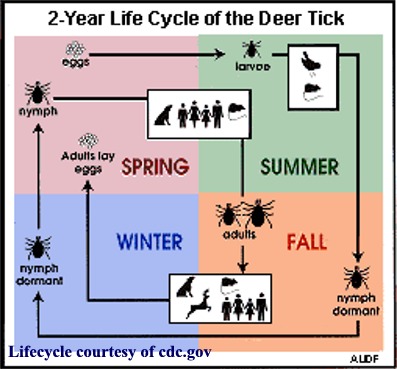|
Once in a
host, B.
burgdorferi reproduces asexually through mitosis to make a
colony. The species has not yet been found naturally outside
of a host, and therefore it needs a host in order to reproduce. It has been known to spread into the blood,
cerebrospinal fluid, heart, retina, brain, muscles, bone, spleen,
liver, and brain (Schnarr, S., Franz,
J., Krause, A., & Zeidler, H., 2006).
While B.
burgdorferi reproduces asexually through binary fission like
most other bacterium, they also have an unique variations of
reproduction. Sometimes a cyst forms in which young B.
burgdorferi form and are later released. Also, buds may
form on the lengthwise section of B.
burgdorferi. These buds can eventually turn into cysts
that contain growing B.
burgdorferi and burst to release the bacterium.
Additionally, B.
burgdorferi is unique in its ability to reproduce essentially
wherever and whenever it needs to while protecting itself from its
hosts' immune system (Karlen, A., 2000).
 The lifecycle of
Borrelia
burgdorferi revolves closely
around the lifecycle of its primary host, Ixoidid
ticks. In early summer,
when a tick larva hatches and attaches to a host, the larva can
become infected with
Borrelia
burgdorferi.
Generally, the ticks host will
have been previously infected with B.
burgdorferi at some point in its lifetime from a different tick
nymph and therefore, continues to carry B.
burgdorferi. This host, a mouse/small mammal for example,
will pass the spirochetes species on to many ticks throughout its
lifetime. Therefore, the tick is B.
burgdorferi's vector (animal that acts as a carrier and
transmitter of a pathogenic organism), while the mouse/small mammal
is B.
burgdorferi's reservoir (a holding area for the pathogenic
species) (Karlen, A., 2000). The lifecycle of
Borrelia
burgdorferi revolves closely
around the lifecycle of its primary host, Ixoidid
ticks. In early summer,
when a tick larva hatches and attaches to a host, the larva can
become infected with
Borrelia
burgdorferi.
Generally, the ticks host will
have been previously infected with B.
burgdorferi at some point in its lifetime from a different tick
nymph and therefore, continues to carry B.
burgdorferi. This host, a mouse/small mammal for example,
will pass the spirochetes species on to many ticks throughout its
lifetime. Therefore, the tick is B.
burgdorferi's vector (animal that acts as a carrier and
transmitter of a pathogenic organism), while the mouse/small mammal
is B.
burgdorferi's reservoir (a holding area for the pathogenic
species) (Karlen, A., 2000).
Once the tick bites into its
host, B.
burgdorferi needs to quickly adapt to a new environment as it
enters through the blood rushing into the tick's mouth and continues
to flow into the tick's gut. Because of the tenacity and
toughness of B.
burgdorferi, it adjusts to the colder temperature and different
immune system. It also changes its nourishment source from
that of the mammalian blood to the hemolymph that flows through the
tick. Once in the tick's gut, B. burgdorferi clings to the lining of the gut through its surface
proteins (explained in the Adaptation
section) and grows colonies in the lining of the gut (Once a colony
is developed, "B.
burgdorferi penetrates the gut wall and multiplies in spaced
between cells" (Karlen, A., 2000). It's ability to
penetrate the gut is directly correlated to B.
burgdorferi's spiral shape and unique flagella movement
allowing it to invade tissues and cells through a cork-screw motion.
B.
burgdorferi remains in this state in the gut until the tick
feeds again. B.
burgdorferi will
then be reactivated and enter the ticks hemolymph
system which carries it to the salivary glands. It is in the
salivary glands were B. burgdorferi can be transmitted through saliva to a new host.
However, the larva tick cannot transmit B.
burgdorferi to a new host; therefore, after growing into a
nymph it must detach from its
host (the mouse/small mammal) and survive the winter (nymph dormant
stage of lifecycle). The following summer the tick will look for its second
host. 
When the tick bites into this new host, B.
burgdorferi again changes its environment as it infects the host
wound. The saliva of the tick surrounds B.
burgdorferi and provides help by altering the hosts immune
system at the site of the wound. The heat shock proteins
(explained in the Adaptation section)
assist this bacterium in surviving the warmer host environment.
The Osps (explained in the Adaptation
section) also help B.
burgdorferi establish a colony within the host. Once again
due to B.
burgdorferi's motile abilities, it can penetrate the tissue of
this secondary host and infect the host allowing the host to become
a reservoir to infect other ticks. When the nymph tick is done
feeding, it drops off its host, becomes an adult, and survives the winter. The
next spring the adult tick can reproduce and once again will attach to another host
(usually a larger mammal) to continue the B.
burgdorferi infectious cycle (Karlen, A., 2000).
|